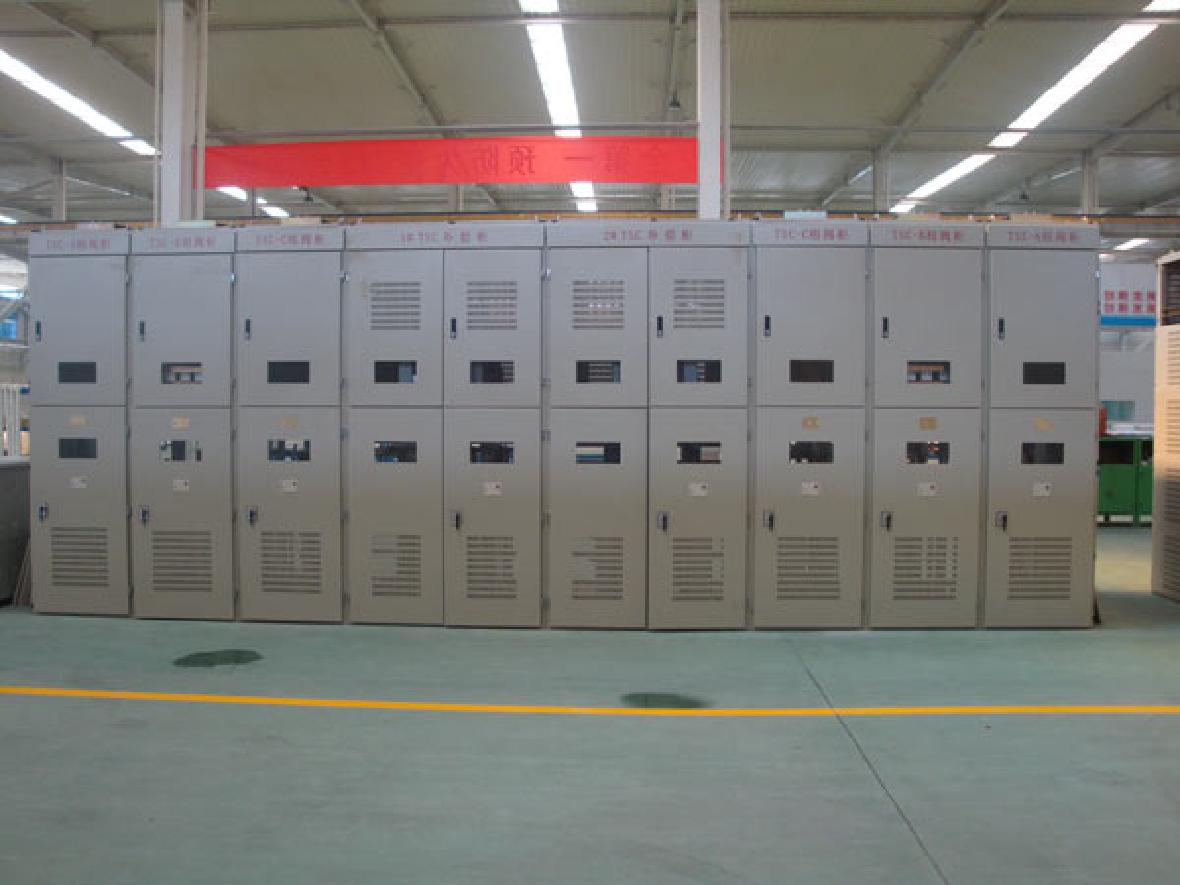TSC-type SVC
Product introduction
TSC (Thyristor Switched Capacitor) SVC reactive power compensation device is composed of control system, triggering system, thyristor monitoring system, pulse transformer, capacitor, reactor, protection unit, etc. The control system detects the reactive power of the power system in real time, automatically determines the capacitor branch that needs to be switched in, and then realizes the switch-on or off of the capacitor bank by controlling the thyristor valve bank of the corresponding branch. The above process is completely automatic, which can ensure that there is no impact, inrush current and transition when switching in the capacitor.
Product features
※ The thyristor valve bank adopts a single-phase vertical structure, which is convenient to install, compact in structure and small in occupation area;
※ The control system of the device adopts DSP+MPU dual processor structure;
※ Real-time tracking of load changes, dynamic compensation of reactive power, and improvement of system power factor;
※ The device adopts optical fiber triggering technology to realize the electrical isolation between the primary system and the secondary system, solving the interference problem with high reliability;
※ The device adopts thyristor to control the switching on and off of the capacitor bank, which truly realizes the zero-crossing on and off of the capacitor bank, and improves the service life of the equipment;
※ There is no surge current, no operating overvoltage, and no arc reignition during the switching process of the capacitor bank;
※ The problem of amplification of the harmonic current by the capacitor bank is fully considered in the process of the main circuit design, so as to ensure the safe and reliable operation of the device;
※ The controller is fully digitalized with LCD display and network communication function;
※The controller has high reliability and is easy to operate. When connected to the system, there is no need to consider the phase sequence of the AC system, and the compensator protection measures are complete;
※ The circuit parameters of the thyristor valve body are carefully designed to ensure low heat generation, compact device structure, and small occupation area;
※ The information transmission between the control cabinet and the thyristor valve body is fully by high-voltage optical fiber without any electrical connection, which completely solves the electrical insulation problem of the low-voltage and high-voltage side control;
※ The dedicated thyristor valve monitoring unit can monitor the operating status of each thyristor in the thyristor valve body in real time with intuitive and concise LCD display;
※ The device adopts a unique self-derived power supply and high-precision DC power supply, for the high-voltage control circuit of the thyristor valve body, which are large in output capacity and high in reliability;
※ The device is suitable for occasions with frequent fluctuation of reactive load impact;
※ The device can improve voltage quality, stabilize system voltage, and suppress voltage flicker;
※ The device can reduce network loss, which is high efficiency and energy saving.
Application fields
① Long-distance power transmission
The power system is currently trending towards high-power, long-distance power transmission, which requires the transmission and distribution system to be more effective. Dynamic compensation can significantly improve the power transmission and distribution performance of the power system. Installing dynamic compensation at one or more appropriate locations on the power grid can achieve the following goals:
(1) Stabilizing the system voltage;
(2) Reducing power transmission loss;
(3) Increasing power transmission capacity;
(4) Buffering power oscillation;
(5) Improving the transient steady state limit.
② Coal mine
The hoist will have the following effects on the power grid during operation:
(1) Causing voltage drop and fluctuation of the power grid;
(2) Low power factor;
(3) The transmission device will generate harmful higher harmonics.
The dynamic compensation device can perfectly solve the above problems.
③ Wind farm booster station
The reactive power consumption of a wind farm changes with the change of wind speed. The dynamic reactive power compensation device can realize fast and dynamic adjustment of reactive power, stabilize the system voltage, improve the power factor, and completely solve the problem of reactive power reverse transmission in wind farms, which is an ideal choice to improve the power quality of the booster station of a wind farm.
④ Electric arc furnace
As a non-linear and irregular load connected to the power grid, the electric arc furnace will have a series of adverse effects on the power grid, the main ones are as follows :
(1) The generation of higher harmonics complicates the voltage distortion;
(2) Leading to serious three-phase imbalance in the power grid, resulting in negative sequence current;
(3) Causing serious voltage flicker;
(4) Low power factor.
⑤Rolling mill
The reactive impact load of the rolling mill will have the following effects on the power grid:
(1) Decreasing the power factor;
(2) Causing voltage fluctuations in the power grid, and in severe cases, making electrical equipment unable to work normally, reducing production efficiency;
(3) Harmful higher harmonics will be generated in the load transmission device, which will cause serious distortion of the grid voltage. Dynamic compensation can perfectly solve the above problems, keeping the bus voltage stable. Without harmonic interference, the power factor is close to 1.0.
⑥ Electric locomotive power supply
Although the electric locomotive transportation can protect the environment, it also can cause serious “pollution” to the power grid. This single-phase load causes serious three-phase unbalance and low power factor of the power grid, and generates negative sequence current. At present, the only way to solve this problem in the world is to install dynamic compensation systems at appropriate locations along the railway to improve the power factor.


